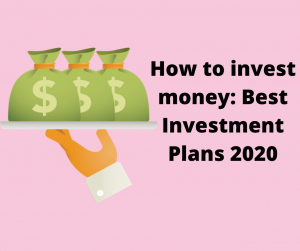
Every one of us wants our ideal money should be utilized in such a way that it can be our savior in the dark days. Who does not face a financial crunch in life? Almost everyone and to help in that period, our investments come as a rescue. Not only this, one must invest to build and fulfill goals. As it truly said, “Money is not everything, but Everything is in money.” You may not buy intangible things from money but the luxury and privilege to live in your self-owned house, owning a car, etc. can be bought from money.
Here we present some of the most sorted Investments for the year 2020.
National Pension System

A Government-backed scheme that allows its investors to invest their money in various market-linked instruments like equities and debt; the final pension amount will be the outcome of returns from these investments. There is 75% to 50% equity exposure that stabilizes the risk-return proportion for the investors under the scheme of the National Pension Scheme. Pension Fund Regulatory and Development Authority of India (PFRDA) regulates the NPS. It is open to all individuals between the ages of 18 and 60 or maximum to the age of 70. Partial amounts (up to 25%) from the NPS can be withdrawn by the individual after 3 years of opening the account.
Mutual Funds
Mutual Funds are the pool of money managed by the Asset Management Companies (AMCs). They have Fund Managers who shoulder the responsibility of managing and monitoring a fund. Thus, the money collected from the number of investors who share a common objective is then put in stocks, bonds, debt instruments, and multiple other money market securities. Mutual Funds can be subscribed at a low cost. You can start investing in mutual funds with as low as of ₹5,000 or ₹500 for monthly Systematic Investment Plan (SIP).
Recurring Deposits
Indian Banks offer Recurring Deposits (RD) which are called term deposits. It allows the investor to make regular deposits and enjoy the benefit of good returns. Investors are allowed to choose the tenure on their own; the most beneficial part of this investment. Usually, the lock-in period of an RD ranges from 1 year to 10 years. It provides customers with the flexibility to invest an amount of their choice per month, and save some amount with ease. 5.00% — 7.85% is the interest rate which is offered by the financial institution. The rate of interest tantamount to that offered for a Fixed Deposit but is higher than any saving accounts.
Gold’s Exchange Traded Funds
ETFs offered by primarily Mutual funds trade in Physical gold where physical gold held in ETF Units equivalent to 1gm each by the custodian banks and they are valued periodically. There is a cost involved in managing ETFs. Investors who invest in ETFs should open a Demat account and also have a trading account opened with Broker to buy or sell the ETF units after the new fund offer for the ETF closes., Just like any other mutual fund, Investors can buy units of the gold funds, and these funds invest in the units of the gold ETFs to give investors similar exposure to gold.
Public Provident Fund (PPF)
It is one of the most popular Long-term Saving-cum-Investment plans. Safety, attractive Interest rate, and tax benefits attributed to its popularity. People who invest in PPF use it as a tool to build a corpus for their retirement. They put a chunk of amount regularly, over long periods (Generally for 15-year-term period maturity which can also be extended). You can invest as small as ₹500 and a maximum of ₹1, 50,000 in a year.
For more updated information related to Investment-related solutions. listen to the podcasts- ‘Paisa Vaisa’ Paisa Vaisa (Hindi) in Hindi | हिन्दी मे | KUKUFM, Money with Monika , Why not Mint Money in Hindi | हिन्दी मे | KUKUFM. The panacea for all the investment problems.



0 Comments